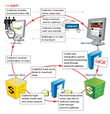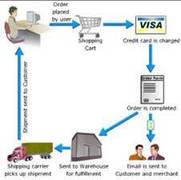Overview of Electronic Commerce

Electronic commerce (EC)
The process of buying, selling, transferring, or exchanging products, services, or information via computer networks.
E-business A broader definition of EC that includes not just the buying and selling of goods and services, but also servicing customers, collaborating with
business partners, and conducting electronic transactions within an organization. EC Organizations brick-and-mortar (old economy) organizations Old-economy organizations (corporations) that perform their primary business off-line, selling physical products by means of physical agents. Virtual (pure-play) organizations Organizations that conduct their business activities solely online.
INTERNET VERSUS NON-INTERNET EC Intranet . An internal corporate or government network that uses Internet tools, such as Web browsers, and Internet protocols
Extranet : A network that uses the Internet to link multiple intranets.
CLASSIFICATION OF EC BY THE NATURE OF THE TRANSACTIONS OR INTERACTIONS
- business-to-business (B2B)
E-commerce model in which all of the participants are businesses or other organizations.
- business-to-consumer (B2C) E-commerce model in which businesses sell to individual shoppers.
E-tailing Online retailing, usually B2C.
- business-to-business-to-consumer (B2B2C) E-commerce model in which a business provides some product or service to a client business that maintains its own customers.
- consumer-to-business (C2B) E-commerce model in which individuals use the Internet to sell products or services to organizations or individuals who seek
sellers to bid on products or services they need. lmobile commerce (m-commerce)
- E-commerce transactions and activities conducted in a wireless environment.
- Location-based commerce (l-commerce) M-commerce transactions targeted to individuals in specific locations, at specific times. -
- Intrabusiness EC E-commerce category that includes all internal organizational activities that involve the exchange of goods, services, or information among
various units and individuals in an organization.
- business-to-employees (B2E) E-commerce model in which an organization delivers services, information, or products to its
individual employees.
- collaborative commerce (c-commerce) E-commerce model in which individuals or groups communicate or collaborate online.
consumer-to-consumer (C2C) E-commerce model in which consumers sell directly to other consumers.
- Peer-to-peer Technology that enables networked peer computers to share data and processing with each other directly; can be
used in C2C, B2B, and B2C e-commerce. le-learning The online delivery of information for purposes of training or education.
- e-government E-commerce model in which a government entity buys or provides goods, services, or information from or to
businesses or individual citizens.
E-business A broader definition of EC that includes not just the buying and selling of goods and services, but also servicing customers, collaborating with
business partners, and conducting electronic transactions within an organization. EC Organizations brick-and-mortar (old economy) organizations Old-economy organizations (corporations) that perform their primary business off-line, selling physical products by means of physical agents. Virtual (pure-play) organizations Organizations that conduct their business activities solely online.
INTERNET VERSUS NON-INTERNET EC Intranet . An internal corporate or government network that uses Internet tools, such as Web browsers, and Internet protocols
Extranet : A network that uses the Internet to link multiple intranets.
CLASSIFICATION OF EC BY THE NATURE OF THE TRANSACTIONS OR INTERACTIONS
- business-to-business (B2B)
E-commerce model in which all of the participants are businesses or other organizations.
- business-to-consumer (B2C) E-commerce model in which businesses sell to individual shoppers.
E-tailing Online retailing, usually B2C.
- business-to-business-to-consumer (B2B2C) E-commerce model in which a business provides some product or service to a client business that maintains its own customers.
- consumer-to-business (C2B) E-commerce model in which individuals use the Internet to sell products or services to organizations or individuals who seek
sellers to bid on products or services they need. lmobile commerce (m-commerce)
- E-commerce transactions and activities conducted in a wireless environment.
- Location-based commerce (l-commerce) M-commerce transactions targeted to individuals in specific locations, at specific times. -
- Intrabusiness EC E-commerce category that includes all internal organizational activities that involve the exchange of goods, services, or information among
various units and individuals in an organization.
- business-to-employees (B2E) E-commerce model in which an organization delivers services, information, or products to its
individual employees.
- collaborative commerce (c-commerce) E-commerce model in which individuals or groups communicate or collaborate online.
consumer-to-consumer (C2C) E-commerce model in which consumers sell directly to other consumers.
- Peer-to-peer Technology that enables networked peer computers to share data and processing with each other directly; can be
used in C2C, B2B, and B2C e-commerce. le-learning The online delivery of information for purposes of training or education.
- e-government E-commerce model in which a government entity buys or provides goods, services, or information from or to
businesses or individual citizens.

E-marketplace
An online market, usually B2B, in which buyers and sellers exchange goods or services; the three types of
e-marketplaces are private, public, and consortia.
E-MARKETPLACE COMPONENTS AND PARTICIPANTS
- Customers
- Sellers
- Products and services
Digital product: Goods that can be transformed to digital format and delivered over the Internet.
Infrastructure - Front end The portion of an e-seller’s business processes through which customers interact, including the seller’s portal, electronic catalogs, a shopping cart, a search engine, and a payment gateway. Back end The activities that support online order fulfillment, inventory management, purchasing from suppliers, payment processing, packaging, and delivery. -
Intermediary
A third party that operates between sellers and buyers.
- Other business partners
Support services Store front : A single company’s Web site where products or services are sold.
E-mall (online mall): An online shopping center where many online stores are located.
TYPES OF STORES AND MALLS
General stores/malls
Specialized stores/malls
Regional versus global stores
Pure-play online organizations versus click-and-mortar stores
TYPES OF E-MARKETPLACES
Private e-marketplaces Online markets owned by a single company; may be either sell-side and/or buy-side e-marketplaces.
Sell-side e-marketplace A private e-marketplace in which one company sells either standard and/or customized products to qualified companies.
Buy-side e-marketplace A private e-marketplace in which one company makes purchases from invited suppliers.
Public e-marketplaces B2B marketplaces, usually owned and/or managed by an independent third party, that include many sellers and many buyers; also known as exchanges.
E-MARKETPLACE COMPONENTS AND PARTICIPANTS
- Customers
- Sellers
- Products and services
Digital product: Goods that can be transformed to digital format and delivered over the Internet.
Infrastructure - Front end The portion of an e-seller’s business processes through which customers interact, including the seller’s portal, electronic catalogs, a shopping cart, a search engine, and a payment gateway. Back end The activities that support online order fulfillment, inventory management, purchasing from suppliers, payment processing, packaging, and delivery. -
Intermediary
A third party that operates between sellers and buyers.
- Other business partners
Support services Store front : A single company’s Web site where products or services are sold.
E-mall (online mall): An online shopping center where many online stores are located.
TYPES OF STORES AND MALLS
General stores/malls
Specialized stores/malls
Regional versus global stores
Pure-play online organizations versus click-and-mortar stores
TYPES OF E-MARKETPLACES
Private e-marketplaces Online markets owned by a single company; may be either sell-side and/or buy-side e-marketplaces.
Sell-side e-marketplace A private e-marketplace in which one company sells either standard and/or customized products to qualified companies.
Buy-side e-marketplace A private e-marketplace in which one company makes purchases from invited suppliers.
Public e-marketplaces B2B marketplaces, usually owned and/or managed by an independent third party, that include many sellers and many buyers; also known as exchanges.
An e-marketplace is a location on the Internet where companies can obtain or disseminate information, engage in transactions, or work together in some way. Most of the e-marketplaces provide two basis functions: 1) they allow companies to obtain new suppliers or buyers for company products, or 2) developing streamlined trading networks that make negotiating, settlement, and delivery more efficient. Currently e-marketplaces exist in many different industries.
E-marketplaces can be structured in several different ways. One way to structure a marketplace is similiar to eBay, where the market maker is neither a buyer or seller, but is a neutral third party. Other e-marketplaces are set up be a consortium of sellers that leverage their combined power to efficiently sell their products to buyers. Buyers can also set up a marketplace to reduce their costs and obtain better purchasing terms. An example of this type of marketplace is Covisant, a marketplace run by the automobile industry. Moreover, large buyers can set up another type of marketplace, a private marketplace, for their supplier networks.
In order for a site to fall into the category of an e-marketplace, the site needs be open to multiple buyers and sellers and needs to provide one or more commerce related functions. These functions include: forward or reverse auctions, vendor catalogues, fixed price ordering, trading exchange functionality, bulliten boards / wanted ads, and RFQ, RFI, or RFP capability. Sucessful e-marketplaces can deliver significant value to their users or members and are profitable.

-Define e-marketplaces and list their components.-List the major types of e-marketplaces and describe their features.-Describe the various types of EC intermediaries and their roles.-Describe electronic catalogs, shopping carts, search engines, and portalsOne Seller, Many Potential Buyersforward auction An auction in which a seller entertains bids from buyers. Bidders increase price sequentially.One Buyer, Many Potential Sellersreverse auction (bidding or tendering system) Auction in which the buyer places an item for bid (tender) on a request for quote (RFQ) system, potential suppliers bid on the job, with the price reducing sequentially, and the lowest bid wins; primarily a B2B or G2B mechanism.“name-your-own-price” model Auction model in which a would-be buyer specifies the price (and other terms) he or she is willing to pay to any willing and able seller. It is a C2B model that was pioneered by Priceline.com.

